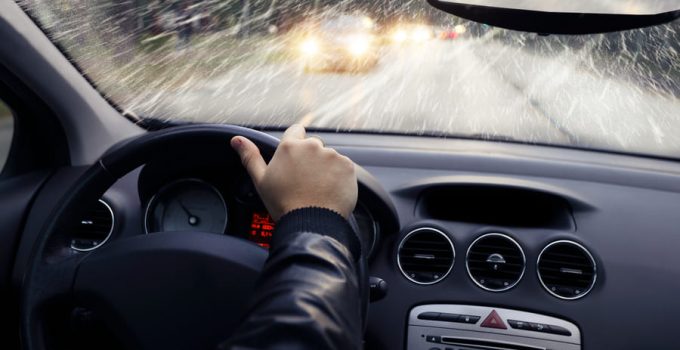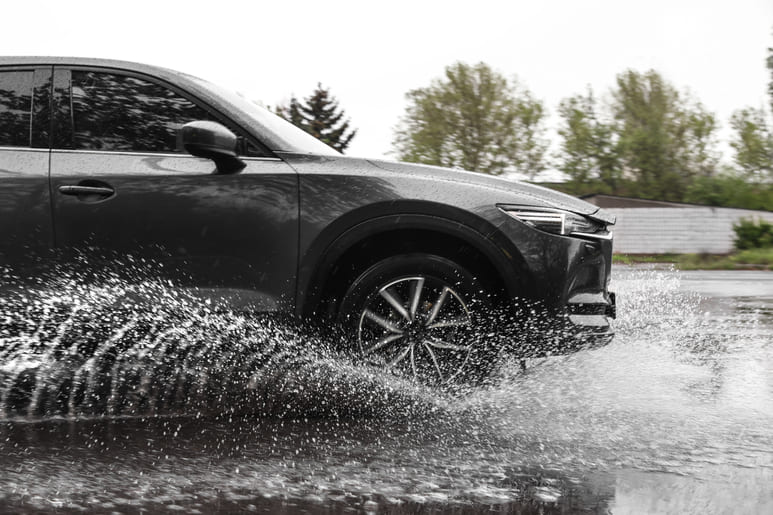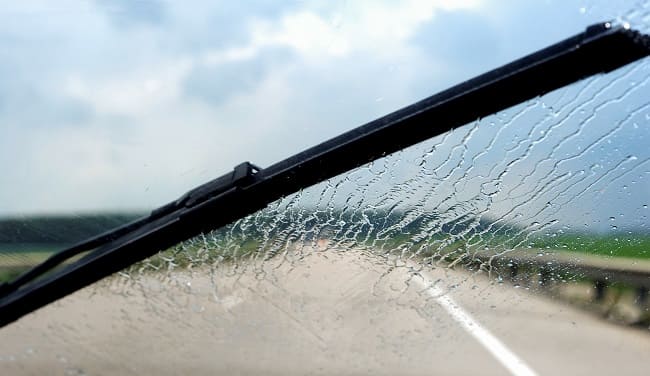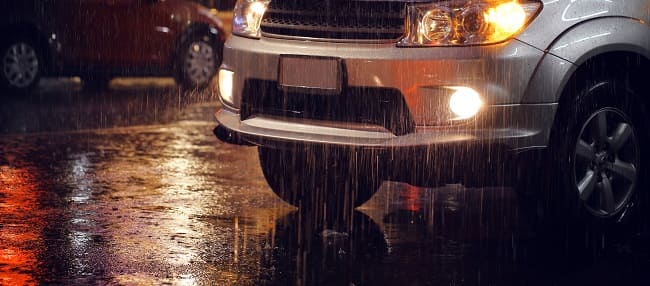
The probability of a road accident when driving in the rain increases on average at 30 – 40%. In this article, we not only clearly state what to look out for, but also provide tips on how to drive in the rain to avoid accidents and problems on the road.
Contents
4 dangers for the driver
- Slippery roads. The grip coefficient of tires on wet asphalt is generally 1.5 to 2 times lower than that of asphalt in dry conditions. The first raindrops are especially dangerous. When these fall to the ground, they lift up the dust on the road, which is made up of oil, fuel, plastic, rubber particles and other substances that mix together to form a thin but very slippery film. The braking distance can increase by a factor of 5 to 10.
- Aquaplaning. When you drive at high speed on wet roads, there is too little time for the water to be displaced between the tire treads and the road surface. Under these conditions, a film of water forms, causing the wheel to lose grip on the asphalt and the car becoming uncontrollable.
- Poor visibility. In heavy rain, visibility on the road deteriorates significantly. In fact, in this case, the contours of the objects cannot be distinguished and the wipers cannot remove the water from the windshield in time. In addition, the windows fog up due to the high humidity. All of this not only makes spotting an obstacle more difficult, but also distracting.
- Drowsiness. When the atmospheric pressure decreases due to the rain, which leads to the decrease in blood pressure and heart rate of the human body, it promotes greater drowsiness. Decreased oxygen supply to the brain creates a feeling of sleepiness. This increases driver reaction time, making driving in these conditions dangerous.

What to check before the wet season?
- Tires. The absolute minimum tread depth is 1.6 mm. If you follow the advice of Dafydd Williams, a professional driving instructor at Mercedes-Benz World, you will need to replace tires once their tread depth reaches 2mm. Even Continental, a famous tire manufacturer, recommends not waiting until extreme tread values are reached before replacing. According to the experts of this company, when you reach 3 and 4 mm, respectively, for summer and winter tires, you should start using new tires. A worn tread is characterized by a reduced depth of sipes and grooves, which ensure slip resistance on wet asphalt and drainage of water at the point of contact between the tire and asphalt.
Those who live in places where it rains frequently, should opt for rain tires. These tires are characterized by a low profile and a special tread pattern that adapts to the road conditions. - Wipers and washers. Although it is recommended to replace the wiper blades twice a year, the quality of the cleaning must be taken into account. If during the operation of the windscreen wipers there are stains and areas that do not get very clean or residues remain on the surface of the windscreen, it is advisable to replace the components. On very rainy days, these defects can even be fatal.
The washer fluid reservoir must contain enough cleaning agent to remove dried dirt from the windscreen. - Brake system. You should always have it checked regularly. Certain defects such as B. a defective brake caliper, are particularly dangerous in the wet because the wheels can slip. The wear of the brake pads leads to a deterioration in braking efficiency and becomes even more serious in the rain because the braking distance increases on wet asphalt.
- Headlights. Certain vehicle lighting defects only show up when the air humidity is high. For example, a poor sealing of the low beam can allow water to seep into its housing, which can burn out the bulbs and cause a short circuit. Condensation of water accumulated on the headlight reflector also deteriorates the light quality. In addition, clogged ventilation openings often lead to fogging of the headlights.
- cabin filter. A clogged cabin filter reduces the air flow speed in the ventilation system. As a result, excess moisture accumulates in the car and promotes fogging of the windows, especially when it rains. To avoid this, we recommend replacing the filter at least once a year.

11 important rules to remember when driving in the rain
- When the first raindrops fall, it is strongly recommended to slow down. At this point, the road is particularly slippery.
- When driving in the rain, the car must not be driven faster than 50 km/h. Higher speeds can result in loss of vehicle control. In addition, braking the car will certainly be more difficult.
- Start braking early. This allows you not only to stop in time, but also to help other drivers understand the situation in time and reduce their speed. Before you enter a bend, you must gradually reduce your driving speed. Try to brake and accelerate gently. In fact, sudden movements can cause slipping and loss of control. Keep a safe distance from the vehicle in front of you.
- Dry the brake pads if they are wet. You can do this by gently pressing the brake pedal several times while driving: This heats up the surface of the components and the excess water evaporates.
- Turn on the headlights: In rainy conditions, the position lights are often not enough, to spot a car on the road. Only use the fog lights if you can't see the road 100m away.

- Keep far away from buses and trucks. These vehicles kick up a lot of dirt from under the wheels.
- Dry the passenger compartment windows. To do this, the heated rear window or the air conditioning must be activated. In this way, it only takes a few minutes to reduce the humidity. In addition, some specialty chemicals improve visibility in rain and fog. Rain repellents should be applied to the outer surface of the glass: they provide a water and dirt-repellent protective layer. Anti-fog agents must be used inside. This leaves the water present on the glass surface in the form of a thin and transparent layer, preventing the formation of drops that reduce visibility.
- Brake slightly before puddles. Water could hide an invisible danger. Aquaplaning is also more common when driving through puddles.
- In very heavy rain, it is advisable to pull over to the side of the road and wait for the rain to subside. Also, make sure you turn on your hazard lights so other road users can see you.
- Stay alert. It can happen that pedestrians cross the street in non-designated areas because they quickly want to protect themselves from the rain. Also watch out for the less alert drivers.
- Avoid driving the car when you are tired. That is very dangerous. If the ride cannot be postponed, it is strongly recommended to stop and get out every now and then to do some loosening exercises. Have you noticed that you can't remember the last kilometers driven? Or that you unknowingly left the lane or drove too close to the edge of the road? Or that you started yawning more often? Or do you have trouble keeping your head in a normal position or focusing your eyes? In all of these cases, you must stop immediately and take a break. Even a 15-minute sleep can save the situation. If you often travel long distances, we recommend that you get an attention assistant to monitor fatigue. This assistant evaluates the current situation by analyzing various data such as the size and changes in the pupil and can then sound a warning signal.
Conclusion
Safe driving in rainy conditions depends on the vehicle's technical conditions and the driver's skills. The timely replacement of wearing parts, the diagnosis of vehicle systems and a calm driving style are particularly important for driving safety. Follow our advice. Buy only quality spare parts for your car and then feel safe in any weather.
